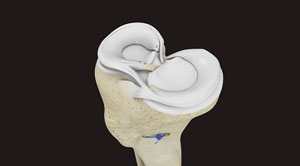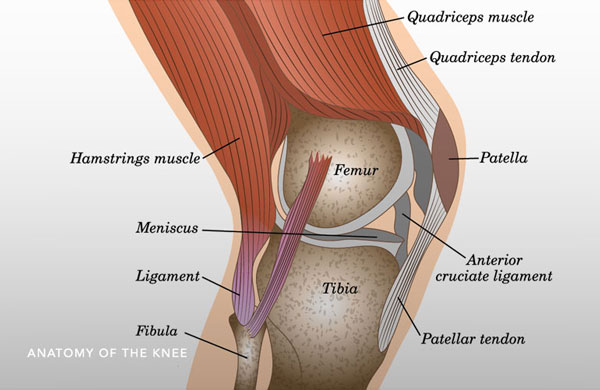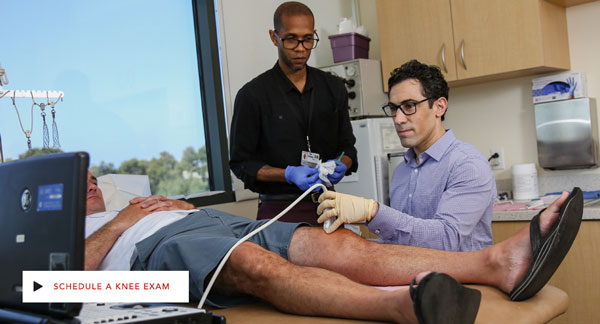
The meniscus is made of two pieces of wedge-shaped cartilage that function to absorb shock between the thigh and shin bones. It is tough and rubbery and stabilizes the knee. It also plays an important role in protecting and maintaining articular cartilage at the ends of the bones that make up the knee joint. The meniscus is easily injured and difficult to repair. Meniscus tears are among the most common knee injuries found both in young, active people involved in sports, and in the elderly.

What causes meniscus tears?
A meniscus tear may be caused by direct contact, or in older people, the tears are often the result of degeneration. Degenerative tears result from to wear and tear over time that weakens and thins the meniscus. When people talk about torn cartilage in the knee, they are talking about a torn meniscus.
Both injured and degenerative tears promote osteoarthritis (OA) of the knee. Actually, meniscus injuries are associated with early onset OA. These tears are identified and treated by how they look, where on the meniscus the tears are located, and their size.
What are the symptoms?
Often the patient has no symptoms. Common symptoms include:
- pain, stiffness, and swelling
- catching, and locking of the joint
- a sensation of the knee giving way, and
- a limited range of motion.
However, most people can still walk. Many athletes play with a torn meniscus. If left untreated, a piece of the meniscus can break off and float in the joint causing the knee to slip, pop or lock.
How is it diagnosed?
Dr. Stark will conduct a complete exam and review your health history, symptoms and the circumstances that caused damage to the meniscus. Tenderness around the joint often indicates a tear. Range of motion tests that cause a clicking sound are also an indication of a meniscus tear.
Imaging studies may be ordered to confirm the diagnosis and rule out other injuries with similar symptoms; and to identify the presence of other knee injuries.

What is the treatment?
Treatment will depend on the type of tear, its size and location, as well as the patient’s age, activity level and any related injuries. Knee arthroscopy is the gold standard for diagnosis and treatment of meniscus injuries.
NONSURGICAL MANAGEMENT
Small tears on the edge of the meniscus may not require repair. If the knee is stable, and symptoms are able to be tolerated, the PRICE protocol will be tried first. Anti-inflammatory medications, analgesics, strength training for the quadriceps, activity modification, bracing and intra-articular injections may also be employed.
PRICE:
- Protect
- Rest
- Ice
- Compress
- Elevate
SURGICAL MANAGEMENT
Meniscal surgery is a commonly performed procedure. The surgical approach is determined by the type, location and extent of the tears, the presence of other knee injuries including to the ACL, and patient preferences.
Because of the vital functions performed by the meniscus, and the risk of OA, even after repair, Dr. Stark will protect as much of the meniscus as possible when repairing or reconstructing the meniscus.
To enhance healing after surgical repair, Dr. Stark may use a variety of restorative procedures.
SURGICAL PROCEDURES:
A partial meniscectomy is the removal of damaged meniscus tissue. Healing time is about 3-4 weeks.
Meniscus repair involves stitching together the torn pieces of cartilage. Whether this is an option depends on the type of tear and the overall condition of the meniscus. The meniscus will heal.
When healed, Dr. Stark may prescribe rehabilitation exercises to restore mobility and strength. Dr. Stark has office in Carlsbad.
Related Topics
- Anterior Cruciate Ligament (ACL) Tear/Reconstruction
- Knee Replacement (Partial and Total Knee Replacement)
- Collateral Ligament (MCL / LCL) Tear/Reconstruction
- Meniscus Tear/Repair
- Multi-Ligament Injuries
- Patellar/Knee Cap Instability
- Posterior Cruciate Ligament (PCL) Tear/Reconstruction
- Tendon Ruptures (Patella Quad Tendon Hamstring)
- Trochleoplasty
